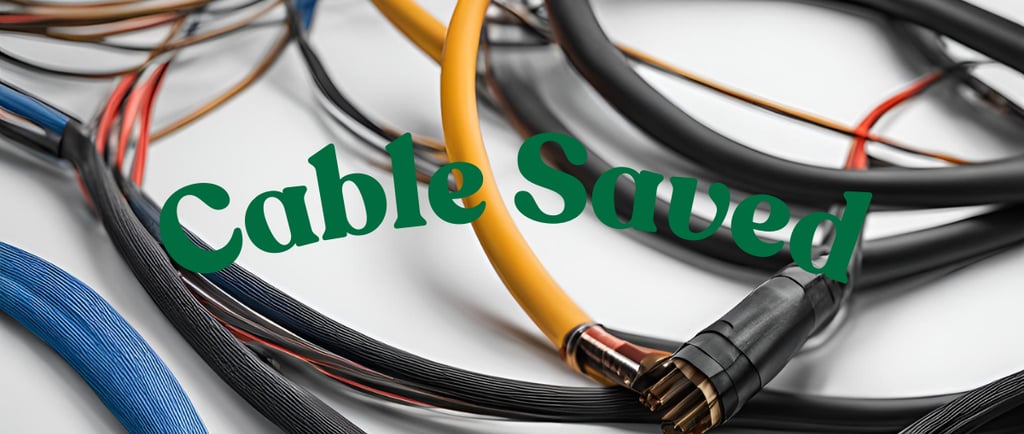Investing in Flexible Cable: Long-Term Savings and Benefits
When evaluating electrical wiring options for your projects, the initial cost is a crucial factor. Flexible cables cost more upfront than traditional wires, but they offer better long-term value. This blog shows how flexible cables provide greater durability, less maintenance, and improved efficiency.These benefits lead to significant cost savings over time, making flexible cables a smart financial choice.
8/30/20243 min read


1. Higher Initial Cost
Flexible cables generally come with a higher initial cost than traditional electrical wires. This price difference stems from the advanced materials and manufacturing techniques required to produce cables that can handle continuous movement and extreme environments. While the upfront cost may seem steep, it is essential to consider the total cost of ownership, including long-term benefits.
2. Durability: A Key Advantage
One of the primary benefits of flexible cables is their durability. In various industrial and commercial settings, cables face mechanical stress, vibration, and environmental factors that can cause wear and tear. Flexible cables are engineered to withstand these conditions better than traditional wires, leading to fewer replacements and repairs. This increased durability ensures fewer disruptions and a longer operational life.
Key Points:
- Resistance to Mechanical Stress: Flexible cables can endure repeated bending and twisting without failure.
- Extended Operational Life: Reduced frequency of replacements saves money in the long run.
3. Reduced Maintenance Needs
Maintenance is a significant factor in the total cost of electrical systems. Flexible cables require less maintenance due to their resilience against damage from mechanical stress and environmental exposure. This durability reduces the need for frequent repairs and replacements, lowering operational costs and minimizing downtime. By decreasing maintenance activities, flexible cables contribute to smoother operations and overall cost savings.
Key Points:
- Lower Repair Costs: Durable construction means fewer repairs are needed.
- Minimized Downtime: Reliable performance leads to fewer operational disruptions.
4. Increased Efficiency
Flexible cables also enhance efficiency in various applications. Their adaptability allows for more effective routing and installation, especially in complex or constrained spaces. This flexibility not only simplifies installation but also optimizes space and resource utilization. Additionally, the reduction in maintenance needs contributes to uninterrupted operations, further boosting overall efficiency.
Key Points:
- Effective Routing: Flexible cables fit well in tight or intricate spaces.
- Improved Productivity: Reduced maintenance and fewer replacements lead to more efficient operations.
The Financial Benefits of Flexible C
1. Long-Term Cost Savings
Despite the higher initial cost of flexible cables, their long-term financial benefits are substantial. The durability, reduced maintenance, and efficiency improvements offered by flexible cables result in significant cost savings over time. Fewer replacements, lower repair costs, and enhanced operational efficiency contribute to overall savings, making the initial investment worthwhile.
Key Points:
- Cost-Effective Investment: Long-term savings from reduced maintenance and replacements offset the higher initial cost.
- Strong Return on Investment: Enhanced performance and durability provide considerable financial returns over the cables' lifespan.
2. Enhanced Performance and Reliability
Flexible cables offer improved performance and reliability compared to traditional wires. Their ability to function effectively under dynamic conditions reduces the risk of electrical faults and failures. This reliability not only enhances performance but also contributes to a more stable and predictable cost structure, further maximizing the financial benefits of investing in flexible cables.
Key Points:
- Reliable Operation: Flexibility ensures consistent performance even under challenging conditions.
- Predictable Financial Planning: Reliable performance aids in better financial forecasting and stability.
Making an Informed Decision
When choosing between flexible cables and traditional wires, consider both initial costs and long-term benefits. Although flexible cables cost more upfront, their durability, low maintenance, and efficiency provide significant savings over time.
Key Considerations:
- Evaluate Specific Needs: Assess the requirements of your application and the conditions in which the cables will be used.
- Factor in Long-Term Benefits: Weigh the potential savings from reduced maintenance and increased durability against the initial investment.
Conclusion
In conclusion, while flexible cables may have a higher initial cost compared to traditional electrical wires, their long-term benefits make them a wise investment. The enhanced durability, reduced maintenance needs, and increased efficiency provided by flexible cables result in significant cost savings and improved performance over time. Investing in flexible cables not only makes financial sense but also ensures a more reliable and efficient electrical system.
For more information on flexible cables and how they can benefit your specific applications, contact us today. Our team of experts is ready to help you make informed decisions that align with your operational needs and financial goals.
